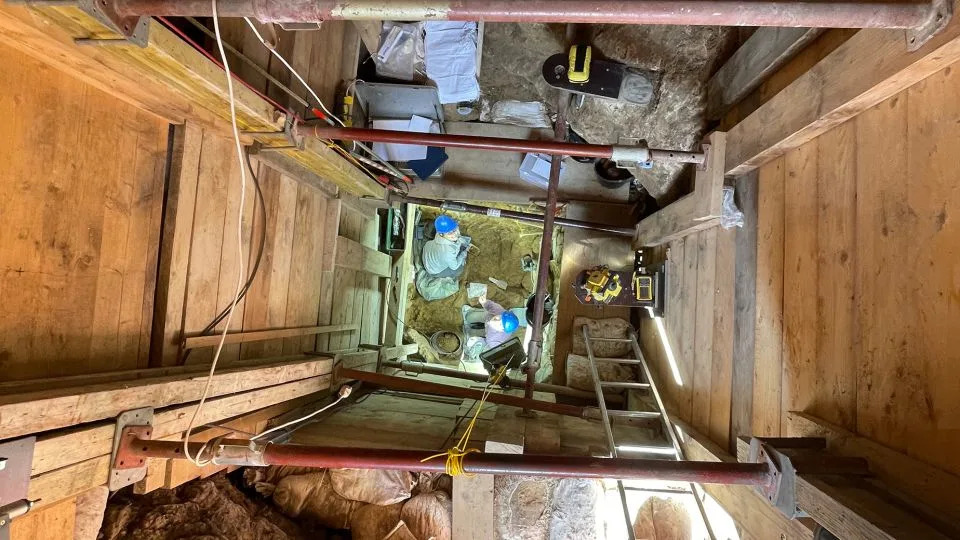Microscopic fragments of protein and DNA recovered from bones discovered in 8-meter-deep cave dirt have revealed Neanderthals and humans likely lived alongside one another in northern Europe as far back as 45,000 years ago.
The genetic analysis of the fossils, which were found in a cave near the town of Ranis in eastern Germany, suggested that modern humans were the makers of distinctive, leaf-shaped stone tools that archaeologists once believed were crafted by Neanderthals, the heavily built hominins who lived in Europe until about 40,000 years ago.
“The Ranis cave site provides evidence for the first dispersal of Homo sapiens across the higher latitudes of Europe. It turns out that stone artifacts that were thought to be produced by Neanderthals were, in fact, part of the early Homo sapiens toolkit,” said research author Jean-Jacques Hublin, a professor at the Collège de France in Paris and emeritus director at the Max Planck Institute for Evolutionary Anthropology in Leipzig, Germany, in a news release.
“This fundamentally changes our previous knowledge about the period: Homo sapiens reached northwestern Europe long before Neanderthal disappearance in southwestern Europe.”
The discovery means the two groups, who once interbred and left most humans alive today with traces of Neanderthal DNA, may have overlapped for several thousand years. It also shows that Homo sapiens, our species, crossed the Alps into the cold climes of northern and central Europe earlier than thought.
Three studies detailing the discoveries and lab analysis were published Wednesday in the journals Nature and Nature Ecology & Evolution.
Earliest Homo sapiens fossils found north of the Alps
The style of stone tool found at Ranis has also been discovered elsewhere across Europe, from Moravia and eastern Poland to the British Isles, according to the studies. Archaeologists call the tool style Lincombian-Ranisian-Jerzmanowician, or LRJ, in reference to the places where it was first identified.
To identify who made the artifacts, the team excavated Ilsenhöhle cave near Ranis from 2016 to 2022. When the cave was first excavated in the 1930s, only the tools were found and analyzed. This time around, the team employed advanced techniques and even utilized a small excavator to dig deeper and more systematically, ultimately uncovering human fossils there for the first time.
“The challenge was to excavate the full 8-metre sequence from top to bottom, hoping that some deposits were left from the 1930s excavation,” said study coauthor Marcel Weiss, a researcher at Friedrich-Alexander University Erlangen-Nürnberg and the Max Planck Institute for Evolutionary Anthropology, in a statement. “We were fortunate to find a 1.7 metre thick rock the previous excavators did not get past. After removing that rock by hand, we finally uncovered the LRJ layers and even found human fossils.”
However, the human remains weren’t immediately identifiable among the hundreds of bone fragments unearthed during the six-year dig. It was only later the team knew definitively that the layers of sediment that contained the LRJ stone tools also included humans remains.

The researchers used proteins extracted from bone fragments to identify animal and human remains they found, a technique known as palaeoproteomics. It allows scientists to identify human and animal bones when their form is unclear or uncertain. Using the same technique, the team also managed to identify human remains among bones excavated during the 1930s.
However, the protein analysis was only able to identify the bones as belonging to hominins — a category that includes Homo sapiens and Homo neanderthalensis, or Neanderthals. To distinguish between the two, the team was able to extract fragments of ancient DNA from the 13 human fossils they identified.
“We confirmed that the skeletal fragments belonged to Homo sapiens,” said study coauthor Elena Zavala, a postdoctoral research fellow at the University of California, Berkeley, and Max Planck Institute for Evolutionary Anthropology, in the release.
“Interestingly, several fragments shared the same mitochondrial DNA sequences — even fragments from different excavations,” Zavala added. “This indicates that the fragments belonged to the same individual or were maternal relatives, linking these new finds with the ones from decades ago.”
Unexpected adaptability
Radiocarbon dating of the fossils and other artifacts in the cave suggested that these early humans were living there from around 45,000 years ago, making them the earliest Homo sapiens known to have inhabited northwestern Europe.
The region would have had a dramatically different climate then, with conditions typical of steppe tundra such as that found in present-day Siberia. The dig revealed the presence of reindeer, cave bears, woolly rhinoceroses and horses. The researchers also concluded that hibernating cave bears and denning hyenas primarily used the cave, which had only periodic human presence.

“This shows that even these earlier groups of Homo sapiens dispersing across Eurasia already had some capacity to adapt to such harsh climatic conditions,” said coauthor Sarah Pederzani, a postdoctoral fellow at the University of La Laguna in Spain, who led the paleoclimate study of the site. “Until recently, it was thought that resilience to cold-climate conditions did not appear until several thousand years later, so this is a fascinating and surprising result,” she said, according to the news release.
William E. Banks, a researcher at the University of Bordeaux in France, said the studies showed how new methods are allowing archaeologists to examine sites in unprecedented detail, improving the ability to pinpoint when a site was occupied.
The “discoveries provide another important piece of the puzzle of this culturally and demographically complex period in Europe,” Banks noted in a commentary published alongside the studies. However, Banks, who wasn’t involved in the research, added that archaeologists “must be careful not to generalize findings from one or two sites.”
He noted that recent discoveries suggested Neanderthals were more culturally and cognitively complex than popular stereotypes suggest and that archaeologists should “not necessarily assume” in all cases that modern humans made more complex styles of stone tools from that pivotal period before Neanderthals disappeared.
CNN.com









